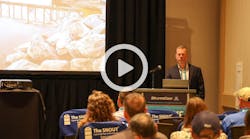About the author: Mark Cavanaugh, CPESC, is regional representative for Price and Co. Inc. and board member of the West Michigan Sediment Control Network. Cavanaugh can be reached at 800.248.8230 or by e-mail at [email protected].
Related search terms from www.waterinfolink.com: green walls, LID, sediment control
The Frederick Meijer Gardens and Sculpture Park in Grand Rapids, Mich., features 125 acres of meticulously cared for horticultural gardens and 160 works of sculpture on permanent exhibition. Celebrating its 15th year and gaining international popularity, the park hosted an increasing number of visitors and necessitated a larger main building.
Construction of the addition was scheduled to take 24 months, with much of it taking place during summers, when visitor numbers were at their peak. Progressive AE, the site engineer for Frederick Meijer Gardens, was asked to design an out-of-public-view construction access road to support heavy construction traffic. The only place where the roadway could be located was on a steep slope between the existing building and an established wetland.
The owner had concern over possible degradation of the wetland from sediment delivery caused by the steep slope and significant construction traffic on the proposed access road. Progressive AE contacted Price and Co. Inc. to discuss what options were available for this environmentally sensitive project, preferring solutions that could be addressed at the design level. Project leaders discussed the possibility of using a mechanically stabilized earth (MSE) retaining wall to support the construction access roadway.
After comparing costs of various wall systems and considering Meijer Gardens’ interest in low-impact development (LID), a naturally vegetated welded wire fascia (WWF) “green” retaining wall was chosen to support the roadway beside the wetland edge. The use of an MSE retaining wall allowed designers to flatten the slope of the roadway and drain storm water away from the wetland. The result was protection of the nearby wetland’s sensitive habitat from sediment created by erosion on the roadway surface. The steep slope and potential for soil erosion was eliminated by using the MSE wall for grade change, creating a near-vertical surface fully protected by vegetation in the WWF system.
LID considerations made a vegetated wall a convincing option. The WWF design made the entire wall face permeable; this allowed storm water to be soaked up readily by plants and soils of the MSE retained earth structure, reducing unwanted storm water runoff. Vegetated walls are cooler because they absorb the heat of direct sunlight and do not unnecessarily increase water temperature in the nearby wetland. Design calculations took into account the heavy construction loads and created a narrow footprint to reduce the roadway’s impermeable surface. By using MSE techniques of geogrid reinforcement, the use of onsite soils was optimized to limit the need for truck transportation of soil from offsite sources, reducing the project’s total cost and carbon footprint.
When looking carefully at all possible options and considering project benefits, solutions with the best possible outcomes usually set themselves apart. Progressive AE used industry-accepted design guidelines for the MSE wall, achieved a low project cost and protected the wetland from soil erosion damage, and Frederick Meijer Gardens received an LID-sensitive green wall structure that blends seamlessly into the background of the beautiful botanic gardens.
Download: Here

